Photosensor (photorelay) for street lighting: design, operating principle and installation tips
An addition to the lighting device in the form of a photo relay allows you to reduce energy consumption.This small and simple device completely takes over the control of turning on/off the light bulbs depending on the level of illumination on the street.
At dusk, a photo sensor for street lighting activates the lighting near the house, and turns it off at dawn. It is simple to design and operate, but before purchasing the optimal model, you need to consider a lot. We'll tell you how to choose the perfect option.
The content of the article:
Operating principle of the photosensor
The basis of the photo relay (twilight switch) that controls street lighting is a photosensitive element that responds to the available brightness of sunlight and artificial light.
When dusk comes, the photo sensor closes its contacts and supplies electricity to lamps mounted on the street near the house. And when the intensity of the light flux increases in the morning, it opens the circuit again, turning off the electrical lighting devices.
The photosensitive relay automatically controls the operation of the lighting device connected to it, turning it off and on as needed.
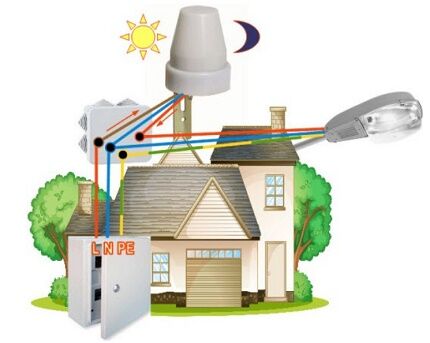
This significantly reduces the electrical energy consumption of street lamps and also extends their service life.After all, in this case they work only when it is really necessary, and not for 8–9 hours a day.
In the private sector, similar systems are installed for lighting:
- street stairs;
- areas near cottages;
- park and garden paths;
- gazebos, barbecue areas and open terraces.
Organizations install photo relays when arranging lighting in the courtyards of apartment buildings, in shopping centers and on the landings of high-rise buildings, as well as when illuminating street structures with advertising. Everywhere the goal is the same - saving energy and the life of lighting devices.
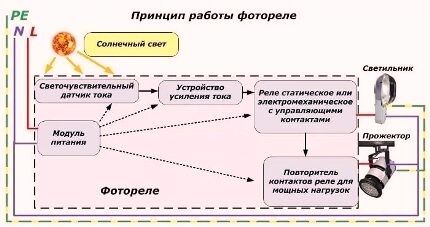
There are several types of photo relays, but the principle of operation is the same for all of them. It has a light-sensitive sensor connected to power that monitors the level of illumination in the controlled area.
At dusk, this sensor closes the relay, turning on the street lights. When the sun rises again, the street lights turn off again.
Main types of electrical appliances
Any photo relay that controls street lighting has three blocks in its circuit with different functionality:
- The perceiver is a photosensor based on semiconductors.
- Intermediate – electric current amplifier.
- Executive – as such a relay (switch).
Structurally, the first of these elements can be removed from the common body. But there are also devices where this photosensitive sensor is mounted in a single unit with the rest of the internal circuitry of this electrical device.
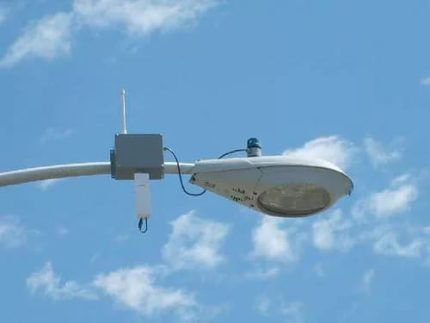
Accordingly, all models of light control photorelays are divided into:
- devices with built-in photocell;
- devices with a separate photosensor, which is removed from the housing.
Equipment with a built-in sensor is installed directly on the street. Its body has higher protection against moisture and dust. In the second case, the switching unit is mounted on a DIN rail in the in-house electrical panel. And the remote sensor is already connected to it via ordinary wires.
In addition to monitoring light levels, such control systems are often equipped with built-in motion sensors, timers and various control buttons. In lighting stores you can also find photo relays that are built on digital controllers. However, these devices are several times more expensive than conventional models.
Digital devices are expensive, but allow you to control lighting fixtures more accurately. The operating principle of household photo relays and the main elements are identical to those found in standard devices.
But these options are complemented by a microcontroller that can be adjusted so that the lights turn on only at certain hours. This makes it possible to fine-tune the relay, linking its operation with weather conditions and even the month of the year.
Selection of photo relays for outdoor lighting
Before you go to the store to purchase a photo sensor to adjust the street lighting system, you should decide on the number and type of lamps to be connected. For one or two flashlights, a relay is enough, the lighting electrical appliances will be connected directly to it.
If there are a lot of light bulbs, then the photo relay will not be able to withstand the current passing through it. In this case, equipment with a magnetic starter is required.
Here, a photosensitive switch triggers a special device, through which the lighting equipment is already powered. Those. a lot in choosing a photosensor model depends on the power of the luminaire circuit connected to it.
The selection of photo relays for the system requires a special approach and mandatory preliminary calculations. solar street lighting. Its power and the number of connected devices directly depends on the average annual number of sunny days in the region, as well as on the number of solar panels in the circuit.
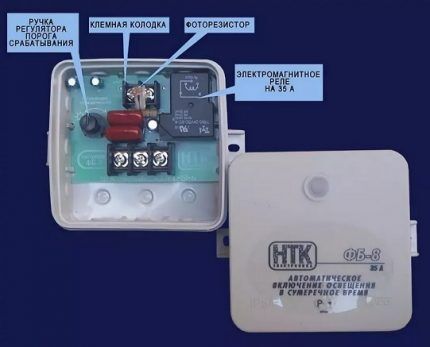
Based on the type of connection to the electrical network, light-control relays for street lighting are divided into:
- single-phase (household, for 220 V network);
- three-phase (for 380 V networks).
However, the switching relay itself and the entire circuit with the photosensor are powered by a voltage of 12 V, which comes from the step-down transformer. The choice in favor of a single-phase or three-phase device depends solely on the network of light bulbs connected to it and the power it consumes.
To install control photorelays for street lighting in private homes, it is best to choose ordinary household models for 220 V. They will be more than enough, especially if economical LED lamps are connected to them.
Technical parameters - what to look for
Some imported electrical appliances are designed for 110 or 127 V networks.Rarely, but you can stumble upon them in lighting stores. They simply cannot work in Russian 220 V networks. They will require the installation of an additional transformer. It is better to immediately take the equipment whose connection will have fewer problems.
The first and main indicator is degree of protection. For outdoor installation, you should choose models with a sealed housing IP65 or higher. And for installation under a roof or in a protected shield, a device with IP44 is quite suitable.
Second parameter - response threshold, which is expressed in Lux. Typically this range is from 2 to 50 Lux. The photo relay has an adjustment for this indicator so that the user can adjust it to his personal preferences. It is worth purchasing a device with an unregulated response threshold only as a last resort.
The third indicator is type of connected lamps. Often a photo relay is designed exclusively for working with incandescent light bulbs, creating active load.
To connect fluorescent devices with an already reactive load, you need to take a different type of twilight switches. And to connect mercury or sodium lamps, you need equipment with an additional protective circuit designed for inrush currents.
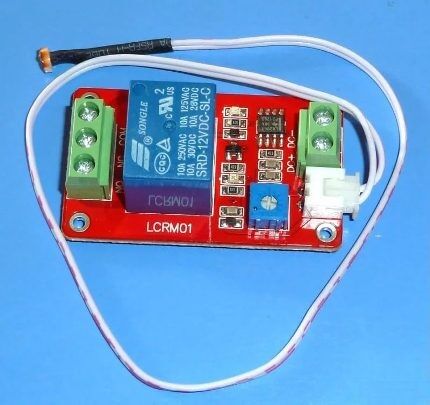
And the last parameters - dimensions And weight. The largest part of the photo relay is the power supply with a step-down transformer inside. The photosensor itself (LED) has very small dimensions.
The contactor or magnetic switch, through which lighting devices are connected. All this should fit in the electrical panel or near the lamp.
Are additional features important?
Many models of light-control relays are complemented by a motion sensor and a timer. The first guarantees that the lighting is turned on only when a person moves through the controlled area, and the second allows you to completely turn off the device during the day, regardless of the level of natural light.
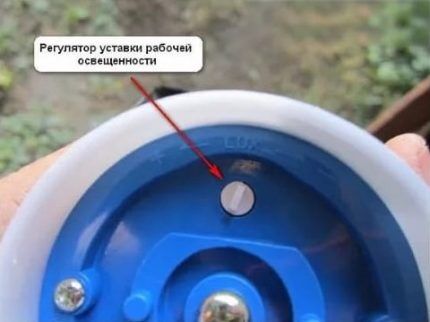
The most expensive models are photo relays with an electronic display and a programmable controller. These devices allow you to set your own work program for each season and occasion.
For example, in winter the lighting will turn on earlier, and in summer later. You can also provide for turning off the relay itself, along with street lamps, after one in the morning, so that they do not burn energy in vain.
Nuances of installing a light sensor
The light control device is usually mounted close to the luminaire connected to it. For each model, the connection diagram is selected in accordance with the instructions in the data sheet. It is mandatory to study it before starting work.
No special skills are required to perform installation. You just need to calculate everything so that electrical lighting devices do not overload the line. The photo relay puts virtually no load on the network. However RCD in the panel and the photosensor itself must be selected based on the number and power of the connected light bulbs.
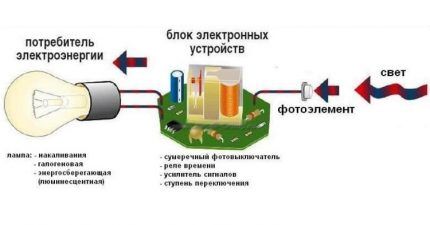
There are several simple standards for installing photosensitive relays:
- It is recommended to connect the twilight switch and the entire line of lighting devices after it to a separate line from the electrical panel with its own circuit breaker.
- It is strictly forbidden to install the photo sensor upside down. On one side it should be open to sunlight, and on the other side light from artificial lighting lamps should fall on it.
- This electrical appliance must not be installed near flammable materials, near heating equipment or chemically active environments.
- If many light bulbs are connected to the photo relay, then a magnetic starter must be provided in the circuit.
The main thing is that light from any lamps should not fall on the photocell. Otherwise, it will constantly not work as expected. The photo sensor responds to any light. It doesn’t matter whether the lighting is artificial or natural from the sun.
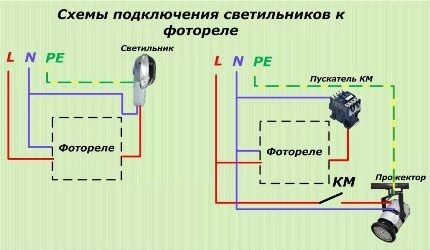
On the body of the photo relay there is a plan with a color designation of all the wires coming from it. As a rule, brown goes to the phase from the panel (“L”), blue to zero (“N”), and red or black to the street lighting fixture. You just need to strip the ends of these wires and connect everything in accordance with the attached electrical diagram.
If the photosensor has two contacts, then one of them is connected to the phase from the shield, and the second goes to the lamp. There is no zero in this case.
In a situation where street lighting is connected via a magnetic starter, it is connected to a photo relay in the same way as a light bulb. And the lighting devices themselves are powered from it.
In this case, the relay does not close the circuit supplying the lamp, but only the starter. A minimum current passes through the switch in such a circuit, so a cheaper and lower-power device will do. The entire load here is transferred to the external contactor.
How to choose lamps for organizing solar-powered street lighting is described in detail in next article, which we recommend that you familiarize yourself with.
Conclusions and useful video on the topic
There should not be any difficulties with selecting and incorporating a light-sensitive sensor into a street lighting system. Everything is extremely simple. The video materials below will allow even novice electricians to understand all the intricacies of installing this device.
Video #1. All the nuances of connecting a day-night photosensor:
Video #2. Review of photo relay for turning on/off night lighting on the street:
Video #3. Description of the connection diagram for the twilight switch via an external contactor:
Light control relays for installation with street lighting devices are simple in design and connection. They greatly simplify the lives of private home owners and allow them to reduce energy consumption. There are many models of such devices in stores. You can always choose with the necessary parameters for a specific situation.
And if you have knowledge and experience in electrical engineering, then such a photo relay can be assembled from a photodiode, a conventional diode, a relay and a pair of transistors with resistors.
Please write comments in the block below. Ask questions about controversial or difficult issues. Share your own opinion, useful information and photographs on the topic of the article.




As an alternative to the photo relay, I use a special adapter for the socket. Using DIP switches, each of which indicates an hour (there are 24 in total), time intervals are set when electricity will be supplied to the lighting devices and when it will not be. You can set as many such periods of energy supply as you like throughout the day. Saves energy on lighting and electric heating devices. A photo relay is, of course, a more flexible device for controlling lighting. I'll practice.
I use single-phase photo relays at my dacha. As additional functions, they have motion sensors installed, which allows you to save a lot of energy. An extremely convenient thing.True, I had to tinker a little with their installation, but this is not such a problem if you have familiar electricians. And besides, the Internet is full of useful material on this topic.
It seems to me that the best method of saving electricity would be not a photo relay, but a motion sensor. These are installed everywhere. Purely logically, does it make sense to illuminate a dark street where there is no one? And as far as I understand, this is exactly what the photo relay is intended for.
Is such savings necessary at the cost of loss of comfort? Man is not a cat, not a nocturnal creature that can see well in the dark. Fine-tuning a motion sensor is not so easy - you will either have to constantly go out into the dark, waiting for the light to turn on, or increase the sensitivity and regularly look for false alarms. It goes so far as to sometimes be triggered by air flows of variable temperature.
But that’s all if we talk about street use. At home, a motion sensor is quite a convenient tool. Here it is more than possible to configure it correctly. The only negative is the inability to use energy-saving light bulbs.
Have you heard about an LED lamp with motion and light sensors? And there are such people. For example, Rubetek-RL-3101. The main advantage is that it does not shine as long as the main corridor lighting is on or there is enough natural light. As it gets dark, it starts to turn on, reacting to someone passing by. Attached a screenshot with characteristics.